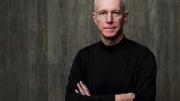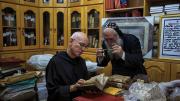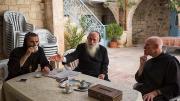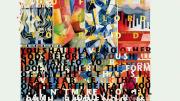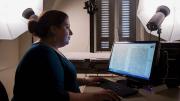How Father Columba Stewart ’79, a Benedictine monk from Minnesota, came to be hiding in a Timbuktu hotel during a jihadist attack last summer is a story that begins in the fifth century.
But the short answer is: he had flown to the medieval center of learning (and site of a United Nations peacekeeping mission since 2013), to start a new archival project—digitizing tens of thousands of documents in the Imam Ben Essayouti Library. The collection holds “everything from commentaries on the Qur’an to letters, scraps of poetry, land deeds, just the whole written culture,” says Stewart, executive director of the Hill Museum & Manuscript Library (HMML) at Saint John’s University, about 80 miles northwest of the Twin Cities.
Christian monks have helped safeguard cultural patrimony for more than a millennium. As followers of Benedict of Nursia (c. 480-540), Stewart says, Benedictines ultimately became “leaders in the copying and transmission of texts.” In the last 15 years, he has taken that tradition to some of the world’s most volatile regions—Syria, Iraq, Israel, and parts of the Balkans—as well as India, Ukraine, and Russia, to help conserve documents threatened not only by religious wars and geopolitics, but also by poverty, natural disasters, and climate change. “We’ve already done a lot of the Christian material,” says Stewart, who holds an Oxford doctorate in theology. “If we want to grow...and we think the preservation of general culture is valuable, then the growing edge of that for us is Islamic materials, not to mention East Asian stuff. Heritage is heritage. And the intellectual argument is, ‘Why not get all the material, of all the sides?’”
HMML is currently digitizing more than 250,000 ancient Islamic manuscripts, books, and literary treasures smuggled out of Timbuktu, in central Mali, in 2012 and 2013. That effort, the library’s largest project to date, is centered at a 12-camera studio in Mali’s capital, Bamako. Catalogued materials are accessible through HMML’s “virtual reading room,” developed and launched during Stewart’s tenure, where more than 25,000 complete manuscripts from libraries across Europe, the Middle East, South India, and parts of the Balkans are already online. HMML also holds thousands of rare books and Bibles, maps, and artwork reflecting Christian culture and theology. More recently, the library has been collecting early printed books (physical counterparts to the virtual, digitized manuscripts online) in Arabic, Armenian, Ethiopic, and Syriac, including important Qur’ans.
For his August trip to Mali, Stewart had lined up Swedish and British support and seats on a UN plane to Timbuktu. Within hours of landing, while eating lunch in the hotel courtyard, he heard gunfire. Ushered into an interior room, he and two colleagues learned by way of phone texts that terrorists had raided the UN headquarters, but that help would arrive.
Hours of waiting wore on. “We heard helicopters overhead, then sporadic shooting”—some of which seemed to come from the hotel garden—“then eerie quiet,” Stewart recalls. “I don’t like just sitting there, not knowing what’s happening, not being able to control anything. We did pray, since all of us are Catholic…and, good news, there was a bottle of scotch in the room, and the hotel people brought us food.” Around 9 p.m. Swedish soldiers arrived and took the group to a command post, where Stewart spent two days getting the digitizing project under way before returning to the bucolic campus on Lake Sagatagan and Saint John’s Abbey, where he’s lived for 37 years.
Stewart isn’t typically that adventurous. Each day, he rises at 5 a.m., swims for 35 minutes, and then, fussy about the strength of his coffee, grinds his own beans and brews a cup in his room. By 7 a.m., he’s in church for the first of four daily prayer sessions with his brothers.
All 150 Psalms are recited in a monthly rotation, inspired by The Rule of Saint Benedict (its 73 pithy chapters range from “At What Hours the Meals Should be Taken” to “If a Brother is Commanded to do Impossible Things”), which was copied and used under Charlemagne and his son, Louis the Pious, to reform Western monasticism.
After breakfast, Stewart gets to work at HMML, breaking for midday prayers and lunch at the monastery, finishing up generally before the 5 p.m. Eucharist. He wears either a black robe—although all that fabric is cumbersome; it catches in the wheels of his office chair, he says, “so you have that Isadora Duncan thing where you’re sort of strangling yourself”—or a practical uniform of jeans and a black mock turtleneck—his “Steve Jobs look.”
Church bells rule the day: so much so that during the relatively freewheeling 2016-17 academic year that he spent as a Guggenheim fellow at Princeton working on his forthcoming book, Between Earth and Heaven: Interpreting the First Thousand Years of Christian Asceticism and Monasticism, he wasn’t always sure how to spend his time. “It was actually hard for me, because there wasn’t a dang bell saying, ‘You do it now, then you’re done,’” he says. “I really need more external framework.”
That said, Stewart chose Saint John’s Abbey for its “progressive, more open approach,” akin to the post-Vatican II Catholicism he’d grown up with in Houston. His mother had been nurtured by “classy, amazing nuns” in Louisiana (her mentor once provided bus fare to the public library so she could read works by Rousseau that were banned by the church), and Stewart realized that “if you are supportive of education and learning, it tends to expand your horizons.”
At Harvard, he planned on a law career until an expository-writing teacher encouraged his penchant for books and language. Switching to history and literature, he focused on nineteenth-century French prose and poetry and English church history. A course with the late Peter Gomes, Plummer professor of Christian morals and Pusey minister in the Memorial Church, helped inspire his lifelong interest in early Christian texts. At St. Paul’s, in Harvard Square, and in his home diocese, Stewart talked with priests about the possibility of ordination, but already knew solitary life in a rectory wasn’t the right path. In writing his senior thesis on early Anglican monasticism, he spent time with the brothers at the Society of Saint John the Evangelist, an Episcopal monastic community on Memorial Drive—making his mother “nervous because she thought I was going to convert.”
The fall after graduation, having spent the summer taking a Harvard Latin course, where he met his “first Benedictine,” Stewart began a doctoral degree in religious studies at Yale. There, he became friends with a second Benedictine, on leave from Saint John’s Abbey to study medieval history. Intrigued by the place, Stewart stayed there the following summer, learned some German, and joined the luminaries and theologians then on campus to celebrate the sesquimillenial of Saint Benedict’s birth.
“I loved the community,” he says. “I liked all these really smart guys, hanging out together and doing serious things, but also having fun, and their being willing to accept me. I think for men the sort of team/group thing is important…there was something about being embraced by the group that was very meaningful at that point in my human development.” The rich academic setting enabled Stewart to pursue scholarship and teach, and not worry about being re-assigned elsewhere. Benedictines’ vows are to their monasteries, not to the order, and each community, relative to parishes, operates with autonomy, setting its own liturgical and other practices in line with the Rule.
Stewart returned to finish a third semester at Yale, earning a “consolation-prize master’s degree,” and moved to the abbey in early 1981. By July, he’d entered the novitiate (he was ordained in 1990), received his robe, and taken the name Columba. Latin for “dove”—evoking peace and the Holy Spirit, he says—it honors his ancestry: Saint Columba, the evangelist from Northern Scotland, not only left “the first recorded sighting of the Loch Ness Monster,” he’s also known as a man who loved books.
Saint John’s University was originally founded as a college by Benedictines from a Pennsylvania abbey who went west to minister to German Catholic immigrants in central Minnesota; it moved to the current 2,500-acre campus in 1866. Walking trails wind through woods and along the lake, where motorized boats are prohibited. A restorative quietude pervades most of the campus, despite the presence of a preparatory school and about 1,700 male undergraduates. (About 1,900 women cross-register for classes, but reside at the sister school, Saint Benedict’s College, down the road, where Benedictine nuns also live and teach.)
The abbey is not cloistered. But it is a private place, with a walled garden and polite signs posted to keep visitors at bay. The 115 brothers have their own key to the university’s gym and pool, and enjoy their own dock on the lake, “where we can hang out and not be bugged,” Stewart quips—though he also means it. “Introversion—it sort of goes with the territory, no question,” he continues. “I like people, but I really like being by myself. After three hours of lecturing, I am just whacked.” (He teaches Christian asceticism at Saint John’s small Graduate School of Theology.)
Neverthless, he has mustered the extroverted drive required to expand the manuscript library’s holdings exponentially, raise funds, and network with donors, scholars, librarians, and project partners around the world (including the British Library and the Centre for the Study of Manuscript Cultures, in Hamburg) while extending the boundaries of HMML’s founding mission.
Established in 1965, HMML first microfilmed materials held by Benedictine monastic libraries in Europe, starting in Austria and Germany, because of fears that another world war, or a nuclear attack, would wipe them out. In the Rare Book Room, Stewart has also found tomes that the earliest Saint John’s monks brought from European monasteries to the Midwestern frontier: “the Gospels printed in Arabic in 1590…Arabic! Here, more than a century ago. They were investing in a future they could not know, and now at HMML we have digital images of thousands of Christian manuscripts from the war-torn Middle East.”
In early 2003, the library director, then a lay academic, called on Stewart, who’d once taken a sabbatical to live and study in East Jerusalem and travel around the Middle East, to help with a new project in Lebanon. “They needed a monk to deal with the church people,” he says: the robes tend to engender trust, or at least scholarly objectivity, he adds, when negotiations about the fate of sensitive materials become politicized and contentious. Since then, in numerous trips to the Old City of Jerusalem, Stewart has worked with Christians and Muslims to digitize documents that belong to family collections and historic communities, including St. Mark’s Syriac Orthodox Monastery.
In Iraq, HMML has worked since 2009 with an organization founded by a Dominican friar to protect library collections. Stewart traveled through parts of Iraq in May with a 60 Minutes camera crew, filming a segment on HMML’s work that is scheduled to air this winter, only to find that many of those materials are now hidden, or have been burned. “We visited all the places where we’d worked that have been destroyed,” he reports. “It was very intense.”
In Montenegro and Croatia, a new project recently began to digitize Church Slavonic literary, artistic, and religious documents, dating to the thirteenth century, that are integral to Serbian cultural history. This winter, Stewart also plans to be in northern India, to work on 2,500 mostly Arabic and Persian manuscripts, some 500 years old, held by the family of the Raja of Mahmudabad, who ruled one of the largest feudal estates in pre-independence India. “While there, we’ll possibly zip up to Kathmandu,” he says, to learn more about the effort to conserve roughly 180,000 ancient manuscripts in libraries damaged by Nepal’s 2015 earthquake. The texts date from the ninth century to the modern era, and cover topics from Hinduism and Buddhism to yoga, poetics, and law.
Ancient documents like these and the thousands of volumes in HMML’s Rare Book Room—a first printed edition of the 1481 Latin Bible with the Glossa Ordinaria that was instrumental in shaping Western Christian theology for generations; leaves of a Coverdale Bible (1535), the first modern English translation of the complete text—excite Stewart. “They can feel as fresh today as when they were printed,” he told an audience on campus last fall for the opening of a permanent library gallery for the Saint John’s Bible. The seven-volume illuminated manuscript envisioned by British calligrapher Donald Jackson and created by artists under his leadership between 1998 and 2011. “I like the mechanics of printing, the cutting and casting of type, the setting up of the page, the pull of the press—I am the son of an engineer,” Stewart continued.“I learned that Gutenberg had been a jeweler, which is how he knew how to carve a perfect letter, make a mold from it, and generate the hundreds, even thousands of ‘e’s or ‘m’s needed to print a book.”
He owns one print from The Saint John’s Bible, Ten Commandments, by California artist Thomas Ingmire, which hangs in his monastery room. In it, the burning bush, the crossing of the Red Sea, the first Passover, and the 12 pillars at Mount Sinai are depicted amid gold letters. In the lower half, black and white letters spell out the Ten Commandments and disperse incrementally, becoming abstract forms, before disappearing into white space at the bottom.
The work, Stewart says, is officially interpreted from bottom to top, as “a progression from empty wordlessness” to where God is perceived through full text, bold colors, and gold-foiled designs,” he says. But he inverts that, reading the image from top to bottom, where “God is met finally in silence and spaciousness, unbounded by form and words. But you have to get there through words, through The Word, both sacred text and Word Incarnate.”
Space, inner and outer, “is a good metaphor for how I live, and for my prayer experience,” he explains later. Each morning he prays in his room, alone. “It’s usually accompanied by a sort of, I won’t call it tears, but a sort of moistening of the eyes. It’s a sense of touching an emotional depth, which the classic writers identify as a pretty important aspect of getting the prayer out of the head and into the heart.” In that “zone,” he simultaneously senses calm containment and boundless expansion.
When traveling, Stewart strives to preserve some semblance of monastic life. He stays in the same hotels, recites prescribed daily prayers stored on his iPad, reads from a daily devotional published by the abbey’s Liturgical Press. “We have a joke,” he adds, smiling: “A group of monks and nuns are traveling somewhere in a plane and the plane crashes on a desert island. What do they do? They get together, and the first thing one says is, ‘OK, what time are we going to have vespers?’”
Another antidote: “I never turn on the TV. Not once,” he says. The world is awfully loud. “People are bombarded by it. Airport TV stuff? Drives me insane. ‘Quit talking at me!’” He winces with irritation. “And those things in the taxis?”—mini-screens cycling “edutainment” content—“I just turn those off.” Or he puts on his noise-canceling headphones. “I’m not a delicate person, or someone who is freaked by people, but I also do need that space. I think everyone does.”
Hiding in that small hotel room in Timbuktu, Stewart tried to focus on more solvable problems, like how to salvage the digitizing project. Still, the situation was scary. The worst moment, he says, came when the shooting sounded so close it seemed an attacker could easily enter the hotel and discover the three foreigners; at dinner the night before, they’d been told of regional kidnappings, and of one Swedish prisoner recently traded for a multimillion-dollar ransom.
The violence left seven people dead. Such outbreaks, the prevailing civil strife across the planet, and the erosion of “civilized disagreement and negotiating,” notably in the United States, are “really troubling,” Stewart says. “And the over-consumption, the consumerist culture? How long is all of this sustainable? I can imagine civilizations collapsing. I mean, I am an historian, it happens periodically, and it can happen with a natural catastrophe—will it be global warming? A disease? The decline of an economic engine?”
And yet, he points out, “Monasteries get wiped out, barbarians come and go, and this year’s barbarians are next year’s educated, courtly princes. Where did Charlemagne come from, after all? They used to be hairy Goths; then they became rulers of the Holy Roman Empire. So, I think Benedictines have a survival gene and a capacity for reinvention. We’re known as people who have a long-term view.”
“The key to our survival as a species,” he adds, “may well be small, sustainable communities. Monks and nuns excel at creating such micro-environments. Some have spoken recently of a ‘Benedict option’ as a way to save Christian values by retreating from society. A clarion call of the Second Vatican Council was to recognize the modern world as it is, and then to work with it, [as] a leaven of reconciliation and kindness in the midst of rapid and dislocating change. That’s my kind of Benedictine life: open to all seekers, meeting people where they are, inviting them into the sanity provided by a structured life centered on gathering together throughout the day to share the ancient wisdom of the Psalms and find a moment of quiet reflection. It certainly works for me.”
